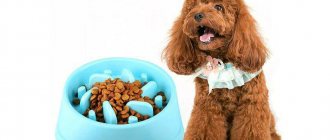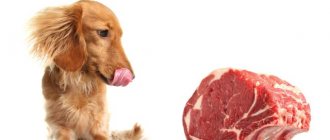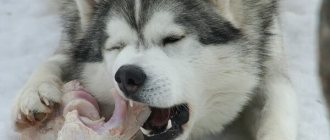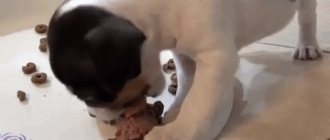By purchasing a cute tiny puppy, not only joy and tenderness come into your home, but also great responsibility for a new life. In the first days of your four-legged friend, his diet is especially important. A conscientious owner should know what to feed a small one-month-old puppy. After all, a dog’s health directly depends on what he eats. In order for your pet to grow up healthy and strong, feeding must be balanced. The body must receive a sufficient amount of nutrients and vitamins.
Frequency of feedings per day
Puppies need a specific number of meals based on their age. The smaller the baby, the more food he needs. When the puppy is about a month old, he is allowed to feed himself, gradually moving from milk to regular food.
You can get acquainted with the approximate plan using the following table:
| Puppy age, months | Number of meals per day | Feeding schedule, hours |
| 1-2 | 5-6 | 7, 10, 13, 16, 19, 22 |
| 2-4 | 4-5 | 7, 10, 14, 18, 22 |
| 4-6 | 3-4 | 7, 12, 17, 22 |
| 6-10 | 3 | 7, 14, 21 |
| 10-12 | 2 | 7-20 |
From night until morning, the puppy should have a break in food. At this time of day, his gastrointestinal tract should not be loaded with food, so it is better not to feed the baby, even if he begins to whine and howl. And so that the pet does not cry from hunger, he needs to be given hearty milk porridge or meat at night.
Expert opinion
Anna Abramenko
An avid dog lover. Experience in veterinary medicine since 2009.
Ask a Question
If one day the owner violated the schedule and missed one feeding of the puppy, there is no need to treat him with a double portion next time.
Additional supplements and treats
In addition to basic products, the following additives can be included in the daily diet of a little barbosie:
- Chalk.
- Crushed quail shell.
- Honey (teaspoon per day).
- Fish oil (teaspoon per day).
- Brewer's yeast.
- Bran.
- Laminaria.
- Sprouted cereal seeds.
- From 3 months you can give beef cartilage and chicken necks.
- From 5 months, you can already include beef tripe and other offal in your baby’s diet.
Nutritional features of one-week-old puppies without a bitch
Sometimes a person has to in some way replace the mother for newborn puppies. They need to be fed every 2 hours, the temperature of the artificial mixture should be no more than +40 degrees. To do this, you will need to purchase a baby bottle with a nipple, a pipette or a syringe with a rubber nozzle.
It is better to feed one-week-old puppies with special milk powder, which can be purchased at pet stores. The composition of this food is most similar to dog milk. In addition, you can prepare a mixture at home based on goat's or cow's milk. For 1 liter you need to take 3 yolks, a pinch of salt, 2 tablespoons of liquid vitamins and a spoonful of corn oil. Mix all this and bring to a temperature of +35 degrees. and feed the baby using a bottle or syringe.
This is interesting: At what age do puppies' eyes open?
Expert opinion
Anna Abramenko
An avid dog lover. Experience in veterinary medicine since 2009.
Ask a Question
At 3 weeks, the puppy should begin to be fed with regular crushed food, monitoring the condition of the four-legged cub.
Regardless of the type of feeding, babies need water. It can be given starting from a two-week period.
Small breeds
Almost all small dogs are predisposed to heart and vascular diseases. Therefore, Yorkie, Toy Terrier, Chihuahua, Pekingese and other small breed puppies should be given a large amount of vitamin supplements from a young age. In addition, the menu of such a dog should be well balanced.
Puppies of small breeds must be provided with adequate complementary feeding with vitamin supplements containing increased amounts of fluoride and calcium. This is due to the structural features of the very vulnerable and long spine, which must have time to strengthen in a short period of time. You cannot compensate for poor food quality by increasing portions.
Diet depending on age
Some owners or breeders teach little pets to eat from a bowl without human assistance by 3 weeks. But most often, first feeding, and then teaching puppies to feed themselves occurs at about a month or a little earlier.
Feeding at 1 month
The basis of a pet’s diet up to one and a half months of age, regardless of breed, is mother’s milk. Therefore, the question of what to feed a small one-month-old puppy does not pose any particular difficulties. During this period, it is very important to follow a nutritional schedule. If the bitch has a large litter, but little milk, or the owner is caring for newborn dogs, then veterinarians recommend introducing early complementary foods - at approximately 2-3 weeks.
When your pet turns 1.5 months old, he will be happy to try other dairy products - low-fat kefir, sour cream, fermented baked milk, cottage cheese. For such a puppy, porridge cooked in milk is also good, which can then be cooked in meat broth.
This is interesting: Cereals approved for feeding dogs
Expert opinion
Anna Abramenko
An avid dog lover. Experience in veterinary medicine since 2009.
Ask a Question
It is important to monitor your pet’s weight gain, which will show how beneficial the chosen diet is for him.
2 months
A puppy at this age is very different from what he was just a month ago. You can already expand the menu, but at the same time you need to carefully and gradually introduce new food. It is recommended to feed your puppy dairy products for at least another 2 months. But their volume should be gradually reduced.
The table below will help you create and diversify a sample menu for a small 2-month-old puppy.
| Feeding time | Recommended Products |
| 7:00 | Cottage cheese with sour cream/oat milk porridge |
| 10:00 | Broth porridge with meat and vegetables |
| 14:00 | Milk, kefir, fermented baked milk, etc. |
| 18:00 | Porridge with meat with added butter |
| 22:00 | Raw meat or fish with vegetables |
In addition, from 1 to 3 times a week you can give a two-month-old baby boiled chicken or raw quail eggs. Fruits will also be useful for a growing body.
Expert opinion
Anna Abramenko
An avid dog lover. Experience in veterinary medicine since 2009.
Ask a Question
Meat for pets without heat treatment should be frozen for at least 3 days, and before serving it is recommended to scald it with boiling water. It is forbidden to combine this ingredient with milk in one feeding.
3 months
From three months, the puppy is transferred to four meals a day. To keep your teeth and bones strong, you should not exclude dairy products from your diet. Food should be varied and rich. If the owner previously treated the furry baby only with natural products, you cannot suddenly switch him to dry food - this will adversely affect the gastrointestinal tract.
A three-month-old puppy's teeth begin to change and his bite begins to form, so it is recommended to give him crackers and soft, non-sharp bones. Don't forget about hygiene.
Feeding from 6 months
At about six months old, small pets begin a stage of enhanced physical development. Because of this, they require much more protein food.
A significant part of the diet consists of lean meat. The puppy's menu also includes vegetables, cereals, grains, boiled or raw eggs. You can give fish a couple of times a week, but due to the low protein content, it needs to be distributed twice as much. Only marine species are suitable for this - cod, hake, pollock.
Interesting article: Which vegetables and fruits can be given to dogs and which cannot
Expert opinion
Anna Abramenko
An avid dog lover. Experience in veterinary medicine since 2009.
Ask a Question
You cannot feed your puppy minced meat. Most often, dogs simply swallow it without chewing - the pet may have problems with the gastrointestinal tract due to the accumulation of undigested residues.
Drinking regime
Water is the main component of puppy nutrition. Water should always be freely available and in sufficient quantity. It is recommended to change the water 2-4 times a day, because when drinking, food debris, saliva, fur, and dirt get into the liquid. You should add water to the drinking bowl 5-6 times a day - or place several drinking bowls in the house.
The maximum daily dosage of water for a dog is from 70 to 100 ml per kilogram of the pet’s weight. If the dog consumes significantly more, then you need to show it to the veterinarian - there is a suspicion of diabetes or other diseases associated with metabolic disorders.
Thus, a miniature 5-kilogram dog should drink from 350 to 500 ml of water per day so that there is no risk of water-electrolyte imbalance. Large and giant breeds are given water in buckets.
The article is of a recommendatory nature. Consult a specialist!
Do you like the article? 297
Dry food in a puppy's diet
Another food option for a growing dog is dry food. It is healthy, properly balanced, and has all the necessary substances and minerals. Such food is divided into the following categories:
- economy - the cheapest food with low energy value and a minimum of beneficial properties;
- premium - middle-priced class, the composition is significantly better than the previous one;
- superpremium - mixtures similar to natural products;
- elite (holistic) - expensive and healthy food with many additives and ingredients.
Veterinarians do not recommend economy food for puppies. Due to the lack of microelements necessary for growth and development, the pet may grow weak and often get sick.
Some tips for feeding puppies prepared food:
- Do not choose food at a low cost - the desire to save money can lead to much greater expenses for treating your pet.
- The best place to find good pet food is in veterinary pharmacies. It must be in a closed package.
- Do not forget to regularly pour clean water for drinking.
- Dry food should never be given together with natural food. When combining such products with different compositions, the functioning of the gastrointestinal tract is greatly disrupted.
- You should not often change brands of food and mix different varieties with each other in one container.
Puppies should be given finished products no earlier than 4 months. Before feeding, it is soaked in warm water half an hour before feeding.
What should the food be like?
How to serve food for feeding puppies from 1 month? You should know that all foods in the diet should be highly chopped. But you shouldn’t grind food in a blender. The puppy must learn to chew its food.
Initially, meat products are boiled, but after a week the meat can already be served raw in two out of three feedings. The food should not be hot or cold; the best option is to have the food at room temperature.
It is important to know the feeding portions for puppies. The amount of food per day for a month-old pet is calculated based on the breed; large dogs require more food.
Vitamins
As a dietary supplement, natural-fed puppies should be given vitamins for general strengthening of the body. Their norm is determined depending on age and breed. But even if the owner took a mongrel puppy, he needs useful supplements no less than a purebred representative.
Among the vitamins recommended for growing dogs, A and D are the leaders, especially in the autumn and winter seasons. They contribute to the normal development of the musculoskeletal system and the prevention of rickets.
Expert opinion
Anna Abramenko
An avid dog lover. Experience in veterinary medicine since 2009.
Ask a Question
If puppies eat dry food, they do not need extra vitamins. In this case, additional substances will only harm him.
Healthy treats for dogs
Like people, pets sometimes want to taste a treat; even the best dog food cannot replace a large bone or pig's ear. However, you should not get carried away with natural bones; fragments can seriously damage the digestive system of dogs, in selected cases causing death. The best option would be bones made from tendons and cartilage; treats are produced by most manufacturers of ready-made dog food. The products contain the required protein and fat content; the bones have a positive effect on the condition of your pet’s teeth and gums.
During training, it is possible to use special cookies, dried treats containing a small amount of flavorings, without having a negative effect on the pet’s health, being used in small doses. The smaller the dog, the less food you should give. Using a similar principle, bones for a pet are selected - the larger the dog, the larger the bone.
Chocolate or sweets should not be used as a treat or incentive during training. The products cause irreparable harm to the dog’s health, causing serious malfunction of organs and systems.
Even a dog feeding professional will not give a clear answer as to what food is best to feed your dog. The difficulty of choosing is determined by the type of food, quality and taste preferences of the dog. It is better to use a mixed type of food, including canned food and dry food. Don't forget to please your pet with treats and treats. Observe whether the food is completely eaten and what food the dog is more inclined to eat. The main thing is not to overdo it with food, then the dog will remain a healthy, faithful and reliable companion of the owner for many years.
Prohibited Products
Newly-made owners are often afraid to make a mistake and feed their furry baby food that is harmful to him. In addition to the fact that you should not give puppies cold and hot food, there is an important list of foods prohibited for them:
- bread, loaf, sweet pastries;
- candies, chocolate, honey, jam;
- everything that causes flatulence and bloating - cabbage, grapes, peas, beans, plums;
- pork;
- River fish;
- fried, spicy, salted, smoked;
- sausages;
- ketchup, mayonnaise, various sauces;
- bones.
?
Food from a human table is unacceptable and dangerous for puppies.
Large breeds
Features of the norms for feeding a puppy of a shepherd dog, labrador, husky, alabai, husky and other large breed dogs include an increased amount of protein compounds. In this case, lean meats should be combined with boiled or stewed vegetables. This food is best given to the puppy before bedtime and only in small portions.
With a properly formulated diet, a large breed pet should gain approximately 150 grams of weight every day. It is allowed to use both ready-made industrial feed and natural food. Ready-made food should be intended for puppies of large breed dogs. To understand how much food to give an animal at a time, you should divide the amount indicated on the package per day by the number of feedings.
You should know that large breeds are predisposed to joint diseases, so you should not overfeed the animal at an early age.
General recommendations
Veterinarians usually emphasize how harmful overeating is for a dog. But lack of food can also cause her health problems. To avoid this, be sure to follow a few simple tips:
- The puppy should always have access to clean water at room temperature. The drinking bowl should be washed regularly.
- It is necessary to create a feeding schedule and not violate it.
- Portions should be calculated based on weight parameters.
- If your pet has eaten much less than usual, there is no need to increase the amount of food at the next feeding.
- There is no strict schedule for the diet, but you cannot replace one product with another that is unequal in composition and nutritional value - for example, put more cereals in a dish rather than meat.
- If you refuse a certain product, you should not worry or force your pet to eat - it is better to give him what he likes.
- Each meal should last no more than 15 minutes. If during this time the puppy has not eaten everything, the owner needs to put the remaining food in the refrigerator.
- Plates with food are placed so that the dog does not have to bend over to them. Otherwise, this will lead to improper formation and development of skeletal bones. An adjustable stand with a tripod will help avoid this.
- You can’t have an active pastime immediately after eating - you should wait 1-2 hours and then start walking, playing and training with your four-legged friend.
Providing proper and balanced nutrition for a growing pet is not difficult. You just need to remember which foods are recommended for the puppy and which are strictly prohibited, and also strictly follow the feeding schedule. If your four-legged friend is cheerful and cheerful, his coat is smooth, shiny, and his teeth are healthy, then all this indicates the right choice of food for his pet and the owner’s care for him.
How many times to feed
For each dog, upon reaching adulthood, the owner selects his own diet. However, there are general rules regarding the frequency and timing of feeding:
- Feeding is done at the same time, on the clock. From the beginning of life, the feeding interval is 2 hours, with age it decreases gradually;
- Evening feeding is best done at about 11 p.m., and morning feeding at 6 a.m.; the number of feedings per day will depend on age;
- If fed naturally, the food should be at room temperature;
- It is unacceptable to mix dry food with natural food;
- If you give raw meat, it is better to freeze it for three days. It is better to feed meat in the evening so that the puppy sleeps better;
- Natural food is crushed and the consistency should resemble thick sour cream; after feeding, you should not physically burden the baby;
- To avoid problems with the formation of the skeleton, feeding is carried out with a special adjustable stand, which “grows” with the dog.
Photo: flickr.com
Bulldog
Bulldog puppies are big eaters, so it is important to monitor your pet's body weight. Feeding a dog in the first month of life is also six servings and maintaining equal periods of time between meals. The diet itself should be varied.
For a bulldog puppy, raw food is a must, because it contains a greater number of minerals and vitamins. Like other dogs, your bulldog should not be given food that is too hot or too cold. The optimal food temperature is from +35 °C to +37 °C. The diet of a one-month-old puppy includes: fish, offal, soups, cereals, vegetables and dairy products.









